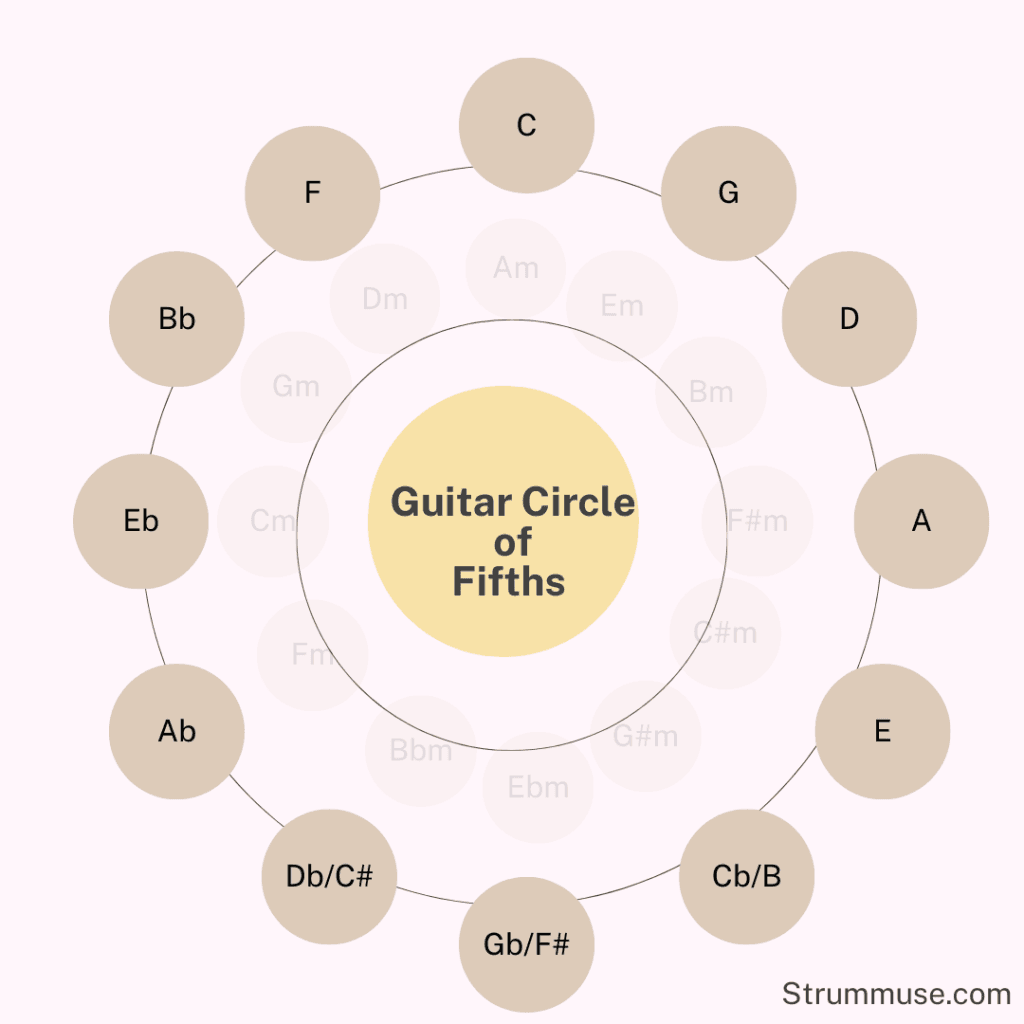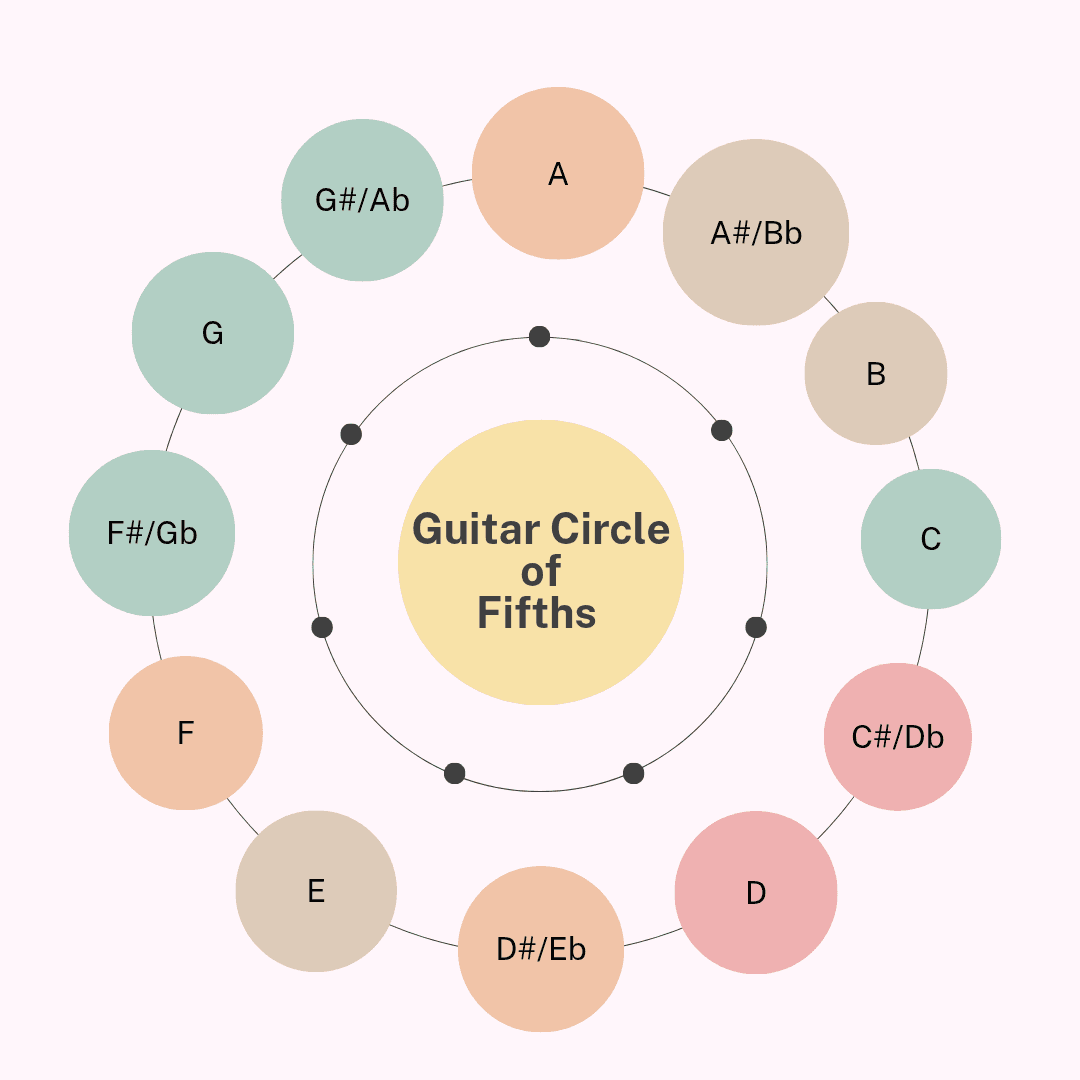Notes in Circle of Fifths
The Circle of Fifths is a handy tool for musicians of all types, especially guitarists. It visualizes the relationship between the twelve pitches of the chromatic scale, making it easier to understand key signatures and how they relate to one another.
In the circle, each note leads to the next by intervals of a perfect fifth. Here’s how it looks:

-
- Starting from C, moving clockwise, you get:
-
- C -> G -> D -> A -> E -> B -> F♯ -> C♭
-
- And if you move counterclockwise, it goes:
-
- C <- F <- B♭ <- E♭ <- A♭ <- D♭ <- G♭
Each of these notes connects to a set of chords that can be built around them, creating a smooth flow of music from one chord to the next.
Building Circle of Fifths
Creating your own circle of fifths can be a fun and educational project. All you need is a piece of paper and a pencil!
-
- Draw a circle: Start with a simple circle on your paper.
-
- Add the notes: Place the note C at the top of the circle. Move clockwise to add G, D, A, E, B, F♯, and finally C♭.
-
- Counterclockwise notes: Now, add the flat keys: F on the left, followed by B♭, E♭, A♭, D♭, and G♭.
It’s also helpful to label each section with the corresponding major and minor keys. This makes it easier to see at a glance which chords belong to each key.
Circle of Fifths Outer Circle
The outer circle of the Circle of Fifths showcases the major keys. Each major chord forms the foundation of many songs and compositions.

-
- C Major: No sharps or flats.
-
- G Major: 1 sharp (F♯).
-
- D Major: 2 sharps (F♯, C♯).
-
- A Major: 3 sharps (F♯, C♯, G♯).
-
- E Major: 4 sharps (F♯, C♯, G♯, D♯).
-
- B Major: 5 sharps (F♯, C♯, G♯, D♯, A♯).
-
- F♯ Major: 6 sharps (F♯, C♯, G♯, D♯, A♯, E♯).
-
- C♭ Major: 7 flats (B♭, E♭, A♭, D♭, G♭, C♭).
Recognizing these major keys will give you a better understanding of harmonies in your favorite songs.
Circle of Fifths Inner Circle
Inside the outer circle, you typically find the minor keys. Each major key has a relative minor key that shares the same key signature. For example:

-
- A Minor: Relative to C Major.
-
- E Minor: Relative to G Major.
-
- B Minor: Relative to D Major.
-
- F♯ Minor: Relative to A Major.
-
- C♯ Minor: Relative to E Major.
This connection between major and minor keys is crucial for songwriting, as it allows for dynamic shifts in emotion and tone within your music.
Finding Chords of Key
Using the Circle of Fifths, you can quickly find the chords associated with a specific key.
-
- Pick a key: Let’s say you choose C Major.
-
- Locate the key: C is at the top of the circle.
-
- Find the related chords: In C Major, the chords would be:
-
- I: C Major
-
- ii: D Minor
-
- iii: E Minor
-
- IV: F Major
-
- V: G Major
-
- vi: A Minor
-
- vii°: B Diminished
This simple process not only aids in playing but also in composing music that resonates well.
Using Circle of Fifths
The Circle of Fifths is more than just a learning tool; it’s incredibly helpful in practical applications.
-
- Chord Progressions: Musicians often use the circle to create smooth transitions between chords. A common progression is I-IV-V-I. In C Major, that would be C-F-G-C.
-
- Modulation: The circle helps musicians change keys within a song. For instance, if you’re in C Major and want to shift to G Major, the circle shows the way.
-
- Improvisation: For guitar soloing, understanding where notes fit within certain chords can lead to more expressive playing.
How to Memorize Circle of Fifths
Memorizing the Circle of Fifths can seem daunting, but with a few tricks, it becomes easier and even enjoyable:
-
- Visualization: Create your own colorful version of the circle. Seeing it in a more artistic light can aid memory.
-
- Use Mnemonics: For example, remember: “Father Charles Goes Down And Ends Battle” to recall the order of sharps.
-
- Practice Regularly: The more you use the circle while playing, the more second nature it will become.
“Music is a language that speaks to the soul. Understanding its fundamental aspects, like the Circle of Fifths, can truly elevate your playing experience.”
Everyone learns differently, so Pick your Guitar & find what techniques resonate best with you and make learning the Circle of Fifths a joyful journey!
FAQ
What is the Circle of Fifths?
The Circle of Fifths is a musical concept that provides essential insights into key signatures, chord progressions, and harmonic relationships. It is structured like a clock, where each hour represents a musical key. Starting from C at the top, each step to the right moves clockwise by perfect fifths, ultimately identifying the 12 major keys.
Why is the Circle of Fifths Important?
This theory acts as a guiding tool for composers and musicians alike. It helps them understand music theory intricacies, making it easier to compose or analyze music. By utilizing the Circle of Fifths, musicians can craft smooth transitions between keys, ensuring that their compositions are cohesive and harmonious.
How to Use the Circle of Fifths in Practice
To make the most of the Circle of Fifths, you can start by familiarizing yourself with the major and minor keys it represents. When practicing scales, consider the order of keys and their related chords. Experiment with chord progressions based on the circle to see how changing keys affects the mood and tone of your music. This exploration not only expands your musical capabilities but also deepens your appreciation of the art.

